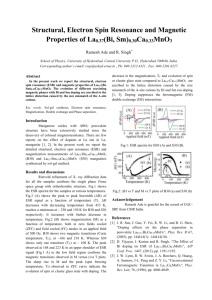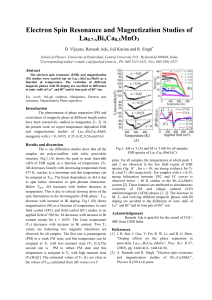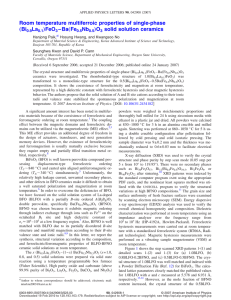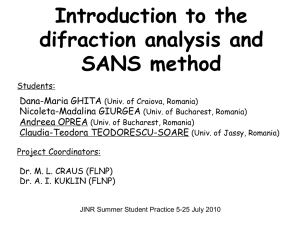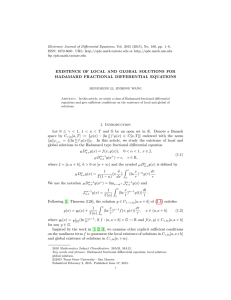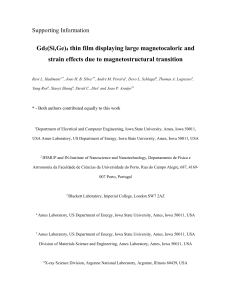Materials Research Bulletin, Vol. 33, No. 7, pp. 1129 –1134,... Copyright © 1998 Elsevier Science Ltd
advertisement
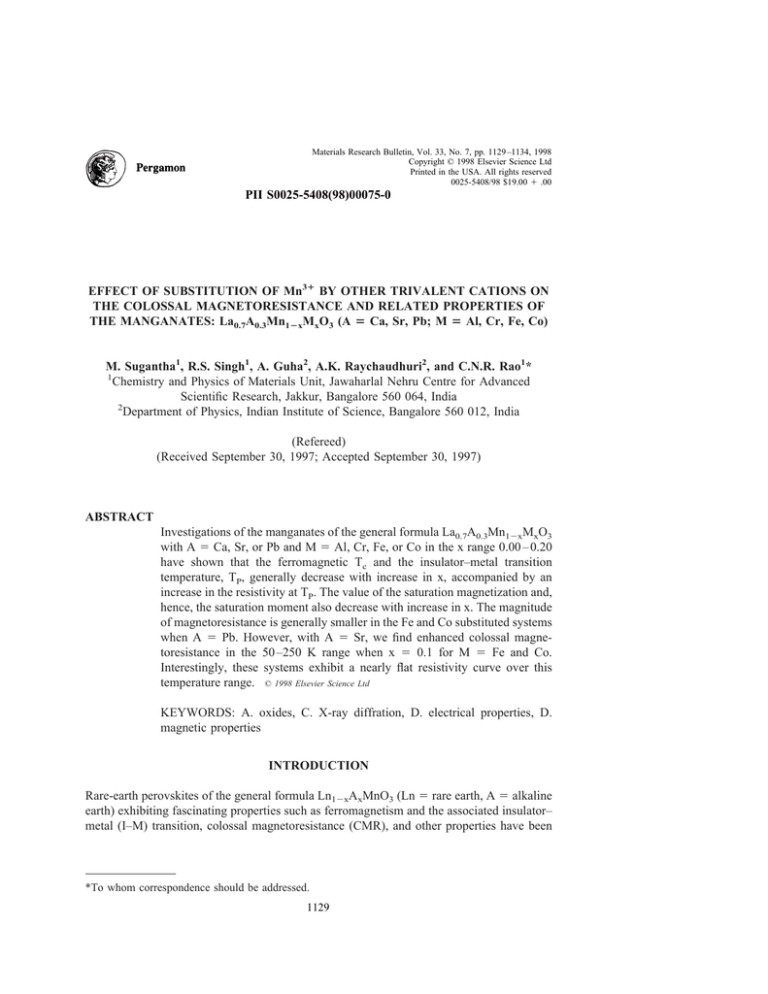
Materials Research Bulletin, Vol. 33, No. 7, pp. 1129 –1134, 1998 Copyright © 1998 Elsevier Science Ltd Printed in the USA. All rights reserved 0025-5408/98 $19.00 1 .00 PII S0025-5408(98)00075-0 EFFECT OF SUBSTITUTION OF Mn31 BY OTHER TRIVALENT CATIONS ON THE COLOSSAL MAGNETORESISTANCE AND RELATED PROPERTIES OF THE MANGANATES: La0.7A0.3Mn12xMxO3 (A 5 Ca, Sr, Pb; M 5 Al, Cr, Fe, Co) M. Sugantha1, R.S. Singh1, A. Guha2, A.K. Raychaudhuri2, and C.N.R. Rao1* 1 Chemistry and Physics of Materials Unit, Jawaharlal Nehru Centre for Advanced Scientific Research, Jakkur, Bangalore 560 064, India 2 Department of Physics, Indian Institute of Science, Bangalore 560 012, India (Refereed) (Received September 30, 1997; Accepted September 30, 1997) ABSTRACT Investigations of the manganates of the general formula La0.7A0.3Mn12xMxO3 with A 5 Ca, Sr, or Pb and M 5 Al, Cr, Fe, or Co in the x range 0.00 – 0.20 have shown that the ferromagnetic Tc and the insulator–metal transition temperature, TP, generally decrease with increase in x, accompanied by an increase in the resistivity at TP. The value of the saturation magnetization and, hence, the saturation moment also decrease with increase in x. The magnitude of magnetoresistance is generally smaller in the Fe and Co substituted systems when A 5 Pb. However, with A 5 Sr, we find enhanced colossal magnetoresistance in the 50 –250 K range when x 5 0.1 for M 5 Fe and Co. Interestingly, these systems exhibit a nearly flat resistivity curve over this temperature range. © 1998 Elsevier Science Ltd KEYWORDS: A. oxides, C. X-ray diffration, D. electrical properties, D. magnetic properties INTRODUCTION Rare-earth perovskites of the general formula Ln12xAxMnO3 (Ln 5 rare earth, A 5 alkaline earth) exhibiting fascinating properties such as ferromagnetism and the associated insulator– metal (I–M) transition, colossal magnetoresistance (CMR), and other properties have been *To whom correspondence should be addressed. 1129 1130 M. SUGANTHA et al. Vol. 33, No. 7 investigated extensively in the last 3 years [1]. Cation-deficient LaMnO3 has been shown to exhibit properties similar to La12xAxMnO3 [2]. Investigations of cation-deficient La12MMnO3 and LaMn12MO3 have shown that while La31 vacancies are tolerated up to 10% without destroying CMR and related properties, vacancies in the Mn31 site have a detrimental effect because the Mn31 ions are part of the active electrical network in these oxides [3]. There have been a few recent studies on the effect of substitution of Mn31 in La12xAxMnO3 by other trivalent cations such as Al and Fe. The substitution of Fe31 in La0.7Ca0.3MnO3 [4] or of Al31 in La0.7Ca0.3MnO3 and Pr0.7Ca0.3MnO3 [5,6] generally appear to decrease the I–M transition temperature, TP, without significantly affecting CMR, when the dopant concentration is not very high. We considered it important to carry out a systematic study of the variation of TP, the ferromagnetic Curie temperature Tc, and the CMR in La12xAxMnO3 with different A-site ions as well as with different dopant ions. The purpose of this study was not only to examine the systematics, but also to determine whether CMR can be optimized with respect to its magnitude as well as the temperature range. In this context, it is noteworthy that CMR is favored by a decrease in temperature and increase in resistivity at TP [7]. In the present study, we have investigated La0.7Ca0.3Mn12xMxO3 with M 5 Al, Cr, Fe, or Co and x 5 0.01– 0.05, La0.7Sr0.3Mn12xMxO3 with M 5 Fe, Co and x 5 0.0 – 0.2, and La0.7Pb0.3Mn12xFexO3 with x 5 0.00 – 0.15. EXPERIMENTAL La0.7Ca0.3Mn12xMxO3 (M 5 Al, Cr, Fe, and Co) samples were prepared as follows: To solutions of the dopant metal (Al, Cr, Fe, or Co) in nitric acid were added the required quantities of the oxides/carbonates of La, Ca, and Mn. The nitrate cake thus obtained was decomposed at 773 K in air and the resulting powder was heated at 1173 K and then sintered at 1273 K for 24 h. Manganates of the type La0.7Sr0.3Mn12xMxO3 (M 5 Fe, Co) samples were prepared by a similar method, except that the nitrate precursor was heated at 1273 K and then sintered at 1573 K for 24 h. The La0.7Pb0.3Mn12xFexO3 samples were prepared by the nitrate route, but the sintering temperature was 1273 K. The manganates were characterized by X-ray diffraction (XRD), using a Rich-Seifert XRD-3000TT diffractometer. The Mn41 content was estimated by redox titrations. Magnetization of the samples were measured with a VSM instrument (Lakeshore model 3300) in a field of 0.01 T. Electrical resistivity and magnetoresistance measurements were performed on bar-shaped pellets, with the four-probe technique in the temperature range 15–350 K. Magnetic fields up to 6T were employed for magnetoresistance measurements. The XRD patterns of the La0.7Ca0.3Mn12xMxO3 samples were indexed on a pseudocubic unit cell. The unit-cell parameters were in the 7.72 6 0.01 Å range. The XRD patterns of La0.7Sr0.3Mn12xMxO3 (M 5 Fe, Co) and La0.7Pb0.3Mn12xFexO3 were indexed on a rhombohedral unit cell. The rhombohedral aR parameter is constant (;5.456 Å) up to a tolerance factor t of 0.936. When t . 0.936, as in La0.7Pb0.3Mn12xFexO3, aR increases. The range of variation of aR is from 5.456 to 5.500 Å. RESULTS AND DISCUSSION Typical resistivity data of La0.7Ca0.3Mn12xMxO3 (M 5 Cr, Fe) are shown in Figure 1. As x increases, the temperature at which the resistivity maximum occurs due to the I–M transition, Vol. 33, No. 7 COLOSSAL MAGNETORESISTANCE 1131 FIG. 1 Resistivity behavior of La0.7Ca0.3Mn12xMxO3 (a) with M 5 Cr and (b) with M 5 Fe. TP, shifts to lower values. The resistivity of the material also increases with the increase in the x value. From Figure 2, we notice a similar behavior in La0.7Sr0.3Mn12xMxO3 (M 5 Fe, Co). The TP in the parent compound, La0.7Sr0.3MnO3 (x 5 0.0), is above 300 K. The TP remains above 300 K for x # 0.03 and gradually decreases to lower temperatures with increasing x value; the x 5 0.2 composition is insulating. The resistivity behavior of La0.7Pb0.3Mn12xFexO3 is comparable to that of the La0.7Sr0.3Mn12xMxO3 (M 5 Fe, Co) system. However, the I–M transition in the former, which occurs at 330 K in the parent compound with x 5 0.0, sharply decreases to 227 K for x 5 0.01. In all the manganates, La0.7A0.3Mn12xMxO3 (A 5 Ca, Sr, and Pb; M 5 Al, Cr, Fe, and Co), the percentage of Mn41 decreases somewhat with the increase in the x content (x $ 0.08). This possibly is due to a small decrease in the oxygen content. Thus, when A 5 Sr, the Mn41 content is ;20% when x 5 0.15 for both M 5 Fe and Co. The same is true for La0.7Pb0.3Mn12xFexO3. An interesting feature in the resistivity curves in Figure 2 is that, close to x 5 0.10, the maxima are broad, especially in the Co-substituted manganate. For all practical purposes, the resistivity in this system is nearly constant over a broad temperature range of 25–300 K. In Figure 2 we show typical magnetization data for La0.7Sr0.3Mn12xMxO3 (M 5 Fe, Co). We note that the Tc is generally greater than TP and that, like TP, Tc decreases with an increase in x. The value of the saturation magnetization, MS, decreases with an increase in x. Thus, the saturation magnetic moment, MS, decreases progressively from 3.6MB for x 5 0.0 to 1.8 MB for x 5 0.10. This is consistent with the fact that the insulating state in the manganates is not ferromagnetic. The MS and MS values decrease with x in a similar manner in La0.7Pb0.3Mn12xFexO3. In Figure 3a, we show the variation of TP with x in La0.7Ca0.3Mn12xMxO3. The TP decreases sharply for x 5 0.01 and then decreases marginally with further increase in x when M 5 Al, Fe, or Co. When M 5 Cr, there is a linear decrease of TP with x. The peak resistivity, rP, at the I–M transition increases markedly up to x 5 0.01 and then less significantly for higher values of x, when M 5 Cr, Fe, or Co (Fig. 3b). For M 5 Al, rP is nearly constant for x . 0.01. We have not observed any significant effect due to magnetic interactions between Mn31 and M31 ions in any of the systems we have studied, including 1132 M. SUGANTHA et al. Vol. 33, No. 7 FIG. 2 Resistivity behavior of La0.7Sr0.3Mn12xMxO3 (a) with M 5 Fe and (b) with M 5 Co. Magnetization data are shown for a few compositions of the M 5 Fe and Co systems. the Cr31-substituted compounds, where there can be ferromagnetic superexchange between Mn31 and Cr31. In Figure 4, we show the variation of TP and rP with x for La0.7Sr0.3Mn12xMxO3 (M 5 Fe, Co) and La0.7Pb0.3Mn1-xFexO3. The TP decreases smoothly with the increase in x in the Sr system (Fig. 4a), accompanied by an increase in rP. In the Pb-substituted system, the TP decreases with the increase in x, but there is a plateau-like behavior for x 5 0.04 6 0.02. In this region, the rP also shows a plateau, although there is a general increasing trend with the increasing Fe31 content. Vol. 33, No. 7 COLOSSAL MAGNETORESISTANCE 1133 FIG. 3 Variation of (a) the insulator metal transition temperature, TP, and (b) the peak resistivity at the transition, rP, in La0.7Ca0.3Mn12xMxO3 with x. In Figure 5, we show the temperature variation of the magnetoresistance (MR) of a few compositions of La0.7Sr0.3Mn12xMxO3 and La0.7Pb0.3Mn12xMxO3 (M 5 Fe and Co). In La0.7Sr0.3Mn1-xMxO3, the magnitude of MR is smaller in the x 5 0.03 compositions FIG. 4 Variation of TP and rP in (a) La0.7Sr0.3Mn12xMxO3 (M 5 Fe, Co) and (b) La0.7Pb0.3Mn12xFexO3. 1134 M. SUGANTHA et al. Vol. 33, No. 7 FIG. 5 Temperature variation of the magnetoresistance in (a) La0.7Sr0.3Mn12xMxO3 (M 5 Fe, Co) and (b) La0.7Pb0.3Mn12xMxO3 (M 5 Fe, Co). compared to the parent x 5 0.00 composition. The magnitude of MR is higher when 0.05 # x # 0.10, especially in the x ' 0.10 compositions, where the resistivity maxima are broad (Fig. 2). This could be due partly to the effect of grain size. The nearly constant and very high CMR (80 –90%) in the x 5 0.10 (M 5 Co) composition is noteworthy (see Fig. 5a). In the Pb system, MR is generally lower in both the Fe- and Co-substituted compositions (Fig. 5b). ACKNOWLEDGMENT The authors thank the Science Office of the European Union and the Department of Science and Technology for their support of this research. REFERENCES 1. 2. C.N.R. Rao, A.K. Cheetham, and R. Mahesh, Chem. Mater. 8, 2421 (1996). R. Mahendiran, R. Mahesh, N. Rangavittal, S.K. Tewari, A.K. Raychaudhuri, T.V. Ramakrishnan, and C.N.R. Rao, Phys. Rev. B 53, 3348 (1996). 3. A. Arulraj, R. Mahesh, G.N. Subbanna, R. Mahendiran, A.K. Raychaudhuri, and C.N.R. Rao, J. Solid State Chem. 127, 87 (1996). 4. K.H. Ahn, X.W. Wu, K. Liu and C.L. Chien, Phys. Rev. B 54, 15299 (1996). 5. C. Martin, A. Maignan, and B. Raveau, J. Mater. Chem. 6, 1245 (1996). 6. J. Blasco, J. Garcia, J.M. de Teresa, M. Ibarra, J. Perez, P.A. Algarabel, and C. Marquina, Phys. Rev. B 55, 8905 (1997). 7. R. Mahesh, R. Mahendiran. A.K. Raychaudhuri, and C.N.R. Rao, J. Solid State Chem. 122, 448 (1996).
